Introduction
It’s no secret the knowledge acquired from tracking metrics are critical to running effective sales and marketing organizations. Metrics such as return on investment, average deal size, click through rates, conversion rates and more, all help you understand what’s working and what’s not when it comes to your company’s growth efforts. However, they only tell part of the story. To truly drive impact and sales, it’s important to bridge the gap between metrics and the business as a whole. That’s where Customer Lifetime Value (CLV) and Customer Acquisition Cost (CAC) come in.
Simply put, CLV is the predicted revenue a customer will bring over the course of their future relationship with a business. It is the metric that will tell you if you’ve been successful in retaining, cross-selling and upselling — the reason customer marketing exists.
CAC is the cost of acquiring a new client. The ability to track digital advertising is one of the forces driving the adoption of this metric and presenting cost effective opportunities that didn’t exist before the Internet.
Together, CLV and CAC provide a big-picture view of performance, profitability and a growth mapping. They can also point out the areas in your business ripe for improvement. That’s why it’s key for sales and marketing to use these metrics. CLV and CAC help direct focus to the right types of prospects and target accounts to help you drive sales and profitability.

What
You’ll
Learn

What CLV and CAC are

Why your sales and marketing team needs to understand CLV and CAC

How to calculate CLV and CAC

How to use CLV and CAC to improve performance and drive sales

Best practice, tips, and action steps
What is Customer Lifetime Value (CLV)
Customer Lifetime Value is a metric that helps you understand the total value (in dollars) a customer is expected to bring over the life of their relationship with your business. More than this, CLV will help you project the profitability of individual customers. This is important because it will help you decide how much you should invest to acquire new customers and to keep existing customers. Once you have a good understanding of CLV, you can use this information to identify the customer segments that will drive the most value for your business.
Fast Facts:
34%
According to research out of the UK, only 34 percent of the marketers surveyed fully understood CLV, what it means and its impact for an organization. And, while almost all respondents (98 per cent) said CLV was important, only 24 per cent said their companies were effectively monitoring CLV. This is a missed opportunity

Why CLV is important
How can you set sales and marketing initiatives if you don’t know how much value your customers bring? The answer is you can’t. Not if you want to be effective. That’s why CLV is often described as the most important key performance metric any business will calculate. Understanding CLV gives you a window into the health of your customer base today and the potential for future growth, which in turn will help you gauge the viability of the overall business. In short, knowing the lifetime value of different customers and customer segments will help you make better decisions and grow.
BEST PRACTICE:
Use CLV to inform and drive decision-making around sales, marketing, product development and customer support.
For example, CLV will help you identify:
- The most profitable type of customers for your solution and those who are poised to drive sales going forward
- How much you can and should spend to attract, acquire, and keep these customers
- Your highest value products and services
- The most productive ways to attract, convert and retain high-value new customers (for example, CLV can be used to design loyalty campaigns and promotions)
- Opportunities to upsell to existing low-value customers
- The right pricing models and understand how they will impact your business into the future
In a real way, CLV takes the pulse of how well you understand your customers. That’s why it’s critical to make CLV a priority. Understanding the strength of your customer relationships provides an indication of future costs and revenue so you can make decisions that will boost your profitability and grow.
Did you know:
60-70%
You’re 60-70% likely to sell to an existing customer, compared to the 5-20% likelihood of selling to a new prospect.
Calculating CLV
Going through the exercise of calculating CLV will give you more than sales numbers. It allows you to dig into and learn from the lifespan of your customers’ journey with you. This includes when, where, why and the cost of their purchases and how often they come back. All of this data can help pave the way for making that journey easier and more enticing for buyers and more profitable for your business.
To get here you’ll need to measure the single values necessary to make the full calculation and more math:
Average purchase value. Take the total revenue over the course of one year and divide this by the number of purchases over the course of that same time period.
Average purchase frequency: Divide the number of purchases over the course of the year by the number of unique customers who made purchases during that time period.
Customer value: Multiply the average purchase value by the average purchase frequency.
Average customer lifespan: Average out the number of years a customer continues purchasing from your company. How do you determine the average length of a customer relationship? You need two key figures. Your total number of customers and the total number of years they’ve been with you. Divide the number of years by the number of customers and that’s the average time customers stay with you.
This will provide a reasonable idea of how much revenue you can expect an average customer to generate for your company over the course of their relationship with you.
There are many different ways to calculate CLV.
Here is a simple and effective method:

CLV = Customer value x average duration of a customer relationship
Take action
Use CLV to maximize customer value. Use industry benchmarks to determine industry averages for each of the components of CLV. How do you compare? Take a close look at your weakest areas and how you can boost customer value to maximize profit.
Make the most of your existing client relationships. Research shows that the odds of selling to a current customer is 60 percent to 70 percent. This compares to between 5 percent and 20 per cent for new customers.
Invest in roles such as customer success and account management to ensure your customers are well supported.
Stay connected by providing valuable content to existing customers using their preferred channels of communication.
Incentivize repeat purchases by creating a customer loyalty program
Reward customer advocacy and referrals.
What is Customer Aquisition Cost (CAC)?
Customer acquisition cost is a critical business metric that is growing in importance and use around the world. It is the cost of winning a customer.
Understanding CAC will help you allocate the appropriate resources to find and obtain new customers and grow profitably. It includes all sales and marketing expenses (ad spend, salaries, commissions, creative costs, technical costs, publishing costs, production costs, overhead) used to find, attract and convert leads into customers.
Why CAC is important?
Knowing your CAC is the key to growing your business. It will also ensure you never overspend on acquiring new customers — a key challenge in the B2B space. CAC is the cost of all your marketing efforts to acquire a new customer. It’s a number investors want to know because when subtracted from the value a customer is expected to bring (CLV) it will help them determine future profitability. Internally, CAC is a significant metric for measuring the success of your marketing campaigns and your ability to grow sales. Lowering the cost of obtaining new customers is an important way to increase profitability.
Take action
Invest in training your salespeople with the skills to sell digitally.
Enable them to connect with prospects on social media platforms such as LinkedIn, Facebook, Twitter and more.
Implement an inbound marketing strategy.
Become a thought leader by leveraging content marketing to bring customers to you.
Spend time with your sales and marketing teams developing your “Ideal Customer Profile” and “Buyer Personas”.
This will ensure you target your marketing efforts to the right buyers, not the largest audience.
Double down on digital.
Online marketing is significantly less expensive than traditional marketing, such as print or trade shows.
Get great at Google.
Optimize your website using tools such as Google Analytics to improve conversion rates.
Fast Facts:
62%
Research shows inbound marketing costs 62 percent less than traditional marketing and generates three times more leads.
51%
Salespeople who use social selling are 51% more likely to reach quota than those who don’t.
28%
CMO Council reports 28 percent of marketers have reduced their advertising budgets and moved to digital marketing.
How to calculate CAC
The math:

Customer Acquisition Cost = Total sales expenses plus total marketing expenses divided by the number of new customers acquired because of these activities in a specific period.
Start by determining the timeframe you want to measure: monthly, quarterly or yearly.
Good to know:
CAC can fluctuate from one time period to the next, based on when campaigns are developed and launched. It can also vary by product, company, industry. For example, higher priced products usually have a higher CAC.
Here’s a look at the average CAC in a variety of industries:
- Travel: $7
- Retail: $10
- Consumer Goods: $22
- Manufacturing: $83
- Transportation: $98
- Marketing Agency: $141
- Financial: $175
- Technology (Hardware): $182
- Real Estate: $213
- Banking/Insurance: $303
- Telecom: $315
- Technology (Software): $395
PRO TIP:
Review CAC twice a year and after each campaign. This will help ensure impact and ROI.
Fast Facts:
20-50%
According to McKinsey, 20 percent to 50 percent of purchases are the result of word-of-mouth referrals.
How CLV and CAC work together
It’s a best practice to measure CLV against CAC and to use this ratio to guide your spending budgets and your marketing, sales, and customer service activities. This ratio provides an important comparison: how much customers bring into the business versus how much the business is spending to attract and acquire them. The objective is to hit on the right balance so you maximize the impact of your spending. Connecting what it costs to acquire a customer to the value that customer is expected to bring and hitting the sweet spot in terms of a ratio between the two is what will help you scale profitably.
For example, Forrester Research suggests that as a best practice you should be able to recover the CAC in about 12 months, and the value of your customers should be three times greater than the cost of acquiring them. Anything less suggests your spending too much to bring on new customers. If the CLV:CAC is greater than 3:1, then you likely aren’t spending enough and so may be missing out on finding and converting new leads
Take action
To get your CLV:CAC ratio closer to 3:1:
Listen to your customers and provide the value they’re looking for. Ask for and act on customer feedback.
Gain access to “free” customers by putting a customer referral program in place. If you convert interested leads provided by existing customers, then your CAC is zero.
Make your sales cycle more efficient. CRM and prospecting tools can help you speed up the sales process and boost the number of sales.
Conclusion
There are all kinds of metrics B2B owners need to know to run an efficient, nimble, and profitable business. So many that it’s easy to see how some get overlooked. CLV and CAC are two that should be prioritized. They will tell you how much your customers are worth to your business over the lifespan of their relationship with you and how much of an investment it took to make them a customer. When you have these numbers, you can make better decisions about how you attract, convert and keep the right buyers and get them to spend more.
Together CLV and CAC can help you improve the overall performance of your sales and marketing functions and enable your business to grow profitably.
Team Revenue

Contact Us
- 401 Bay Street, 16th Floor, Toronto ON, M5H 2Y4
- info@teamrevenue.com
- sales@teamrevenue.com
- 844-444-0000
Copyrights © 2020 Team Revenue


